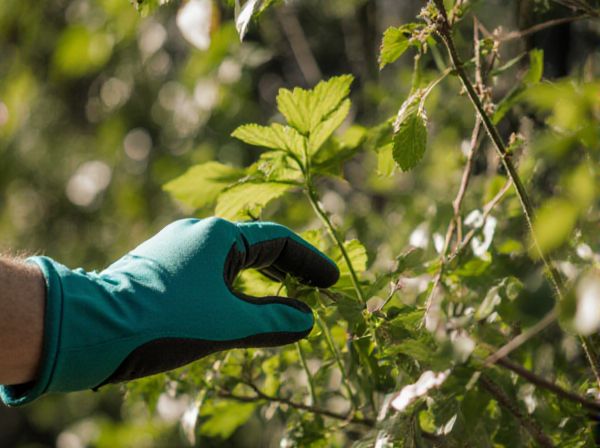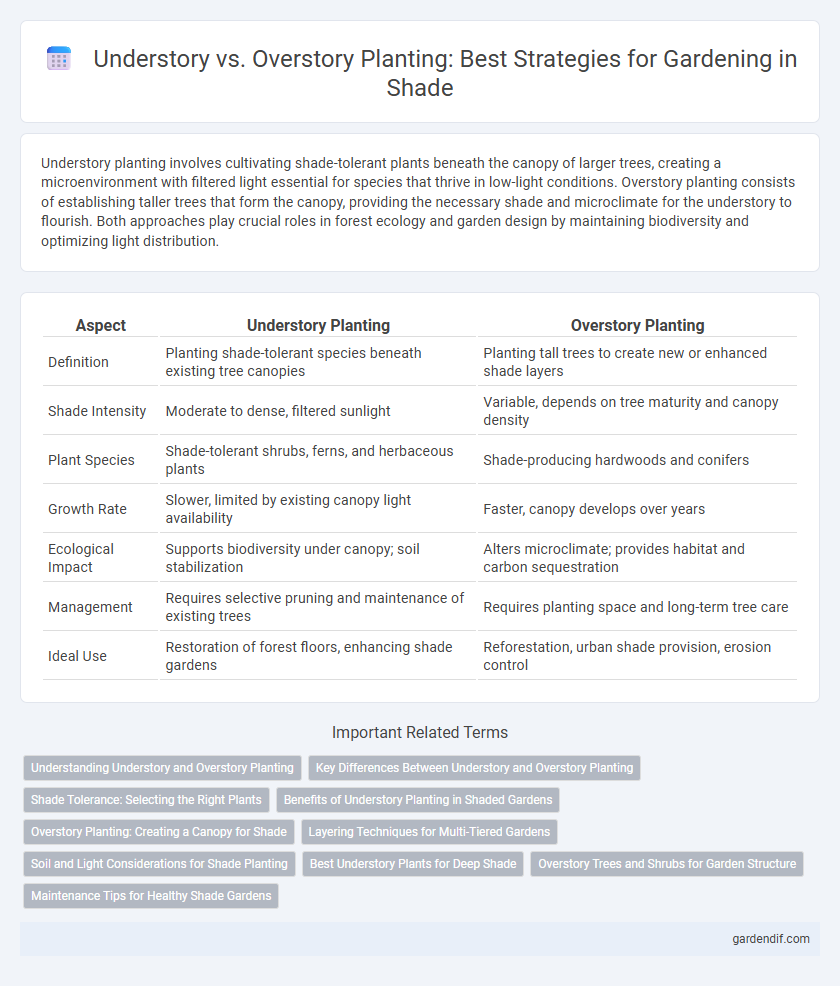
Understory Planting vs Overstory Planting Illustration
Understory planting involves cultivating shade-tolerant plants beneath the canopy of larger trees, creating a microenvironment with filtered light essential for species that thrive in low-light conditions. Overstory planting consists of establishing taller trees that form the canopy, providing the necessary shade and microclimate for the understory to flourish. Both approaches play crucial roles in forest ecology and garden design by maintaining biodiversity and optimizing light distribution.
Table of Comparison
| Aspect | Understory Planting | Overstory Planting |
|---|---|---|
| Definition | Planting shade-tolerant species beneath existing tree canopies | Planting tall trees to create new or enhanced shade layers |
| Shade Intensity | Moderate to dense, filtered sunlight | Variable, depends on tree maturity and canopy density |
| Plant Species | Shade-tolerant shrubs, ferns, and herbaceous plants | Shade-producing hardwoods and conifers |
| Growth Rate | Slower, limited by existing canopy light availability | Faster, canopy develops over years |
| Ecological Impact | Supports biodiversity under canopy; soil stabilization | Alters microclimate; provides habitat and carbon sequestration |
| Management | Requires selective pruning and maintenance of existing trees | Requires planting space and long-term tree care |
| Ideal Use | Restoration of forest floors, enhancing shade gardens | Reforestation, urban shade provision, erosion control |
Understanding Understory and Overstory Planting
Understory planting involves growing shade-tolerant plants beneath the forest canopy, benefiting from filtered light and cooler microclimates that promote biodiversity and soil health. Overstory planting focuses on establishing taller tree species that form the upper canopy, providing essential shade, reducing erosion, and creating habitats for diverse wildlife. Mastery of both understory and overstory planting techniques is crucial for sustainable forest management and ecosystem restoration.
Key Differences Between Understory and Overstory Planting
Understory planting involves growing shade-tolerant plants beneath the forest canopy, benefiting from filtered light and protection from harsh weather, while overstory planting refers to establishing taller tree species that form the upper canopy layer, receiving full sunlight. Key differences include light availability, root competition, and growth rates, with understory plants adapting to lower light conditions and slower growth compared to overstory species, which require more space and nutrients for rapid development. Understanding these distinctions is crucial for effective forest management, biodiversity conservation, and landscape design.
Shade Tolerance: Selecting the Right Plants
Understory planting requires species with high shade tolerance, such as ferns, hostas, and astilbes, which thrive under the filtered light beneath trees. Overstory planting focuses on sun-loving trees like oaks and maples that create the canopy responsible for shade production. Selecting the right plants based on their shade tolerance ensures healthier growth and sustainable garden design.
Benefits of Understory Planting in Shaded Gardens
Understory planting enhances soil moisture retention and reduces erosion by creating a protective layer beneath the canopy, promoting healthier root systems and biodiversity. It supports shade-tolerant species like ferns and hostas that thrive in low light, contributing to a more resilient and visually dynamic garden ecosystem. This method improves microclimate regulation within shaded gardens, leading to moderated temperature fluctuations and sustained plant vitality.
Overstory Planting: Creating a Canopy for Shade
Overstory planting involves strategically placing tall trees to form a dense canopy that provides effective and consistent shade, reducing ground temperature and protecting understory plants from excessive sunlight. This method enhances microclimate regulation, conserves soil moisture, and supports biodiversity by creating habitats for various wildlife species. Proper species selection and spacing maximize canopy cover while ensuring long-term growth and environmental benefits.
Layering Techniques for Multi-Tiered Gardens
Understory planting involves selecting shade-tolerant plants that thrive beneath the canopy layer, creating a lush, diverse lower tier that supports soil moisture retention and biodiversity. Overstory planting focuses on taller trees that form the upper canopy, providing critical shade and microclimate regulation essential for the overall garden ecosystem. Effective layering techniques combine both understory and overstory plants, optimizing light distribution and ecological balance to establish harmonious multi-tiered garden environments.
Soil and Light Considerations for Shade Planting
Understory planting requires selecting shade-tolerant species that thrive in nutrient-rich, well-drained soils with limited light, often filtered through the canopy of overstory trees. Overstory planting involves species adapted to full sun or partial shade with deeper root systems to access moisture and nutrients below the soil surface, supporting a taller canopy that influences microclimate and soil composition. Soil moisture retention and light diffusion play critical roles in determining plant health and growth patterns in both understory and overstory shade environments.
Best Understory Plants for Deep Shade
Understory planting in deep shade environments requires selecting plants tolerant of low light and high moisture, such as ferns, hostas, and astilbes, which thrive beneath a dense tree canopy. Overstory planting involves taller trees that provide the shade necessary for these understory species to flourish. Choosing shade-adapted perennials with broad leaves enhances photosynthesis efficiency, ensuring robust growth even in heavily shaded conditions.
Overstory Trees and Shrubs for Garden Structure
Overstory trees and shrubs form the essential framework of garden design, providing height, shade, and structural layering that supports biodiversity and microclimate regulation. By planting overstory species, gardeners create a canopy that moderates sunlight, reduces soil erosion, and enhances the overall landscape architecture. Selecting native overstory plants such as oak, maple, or holly ensures ecological compatibility and long-term garden resilience.
Maintenance Tips for Healthy Shade Gardens
Understory planting requires regular pruning to prevent overcrowding and ensures adequate airflow, which reduces disease risk in healthy shade gardens. Overstory planting demands careful monitoring of tree root competition and moisture levels to support the growth of shade-tolerant plants underneath. Both methods benefit from mulching to retain soil moisture and seasonal soil testing to optimize nutrient management.
Understory Planting vs Overstory Planting Infographic

 gardendif.com
gardendif.com